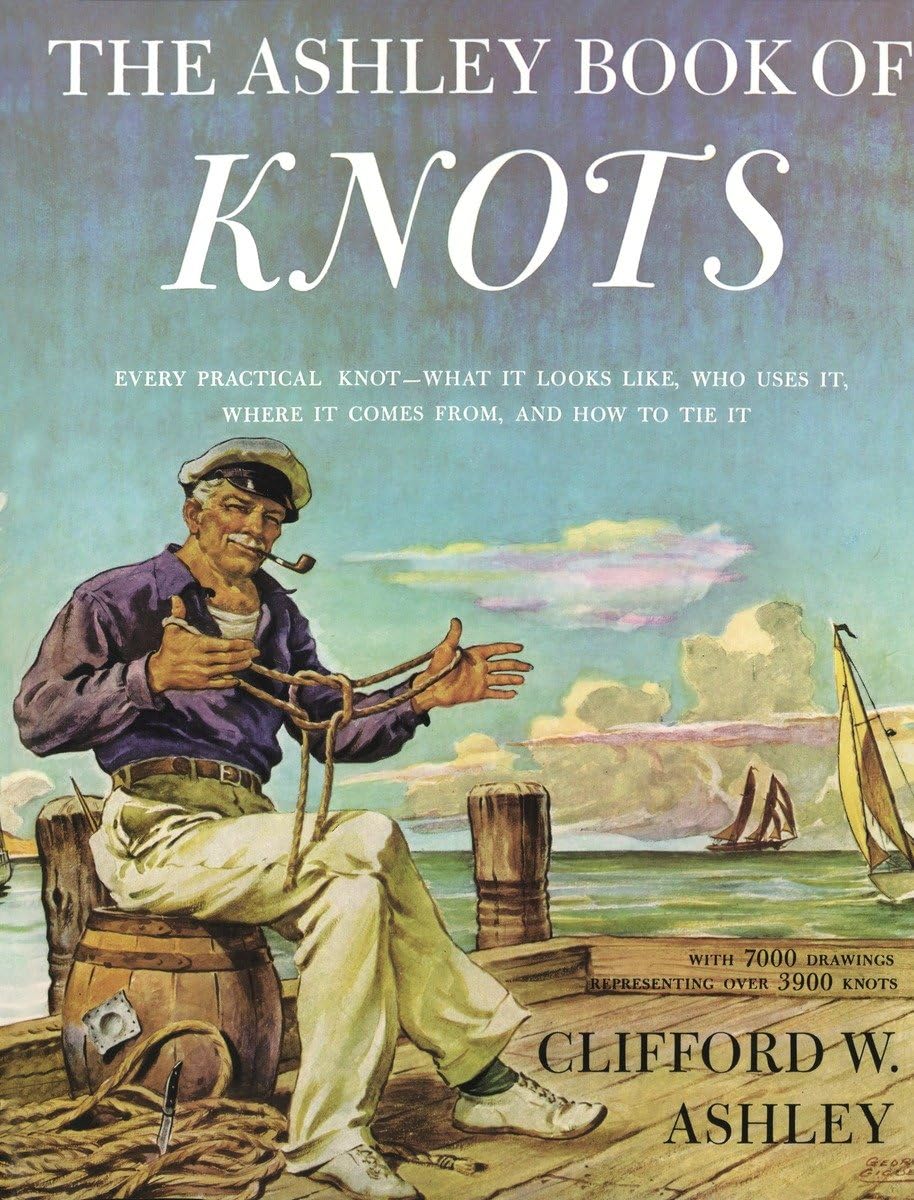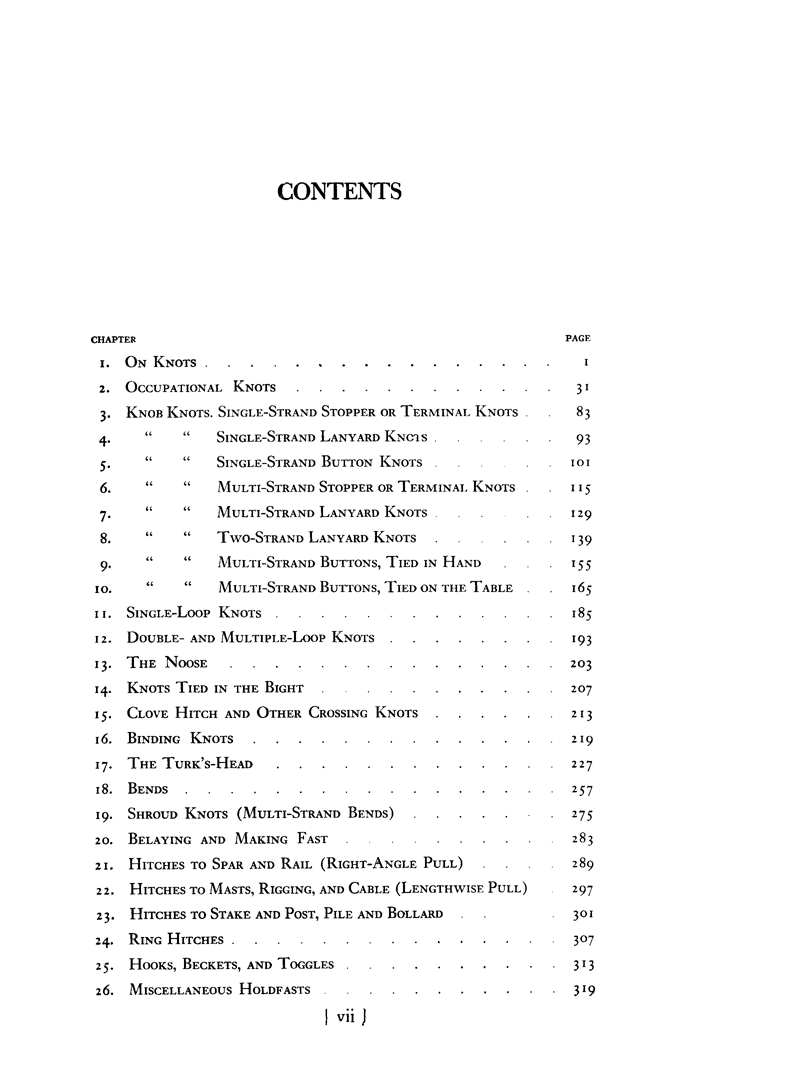Ashley Book of Knots
 THE ASHLEY BOOK OF KNOTS -- Every practical knot -- what it looks like, who uses it, where it comes from, and how to tie it, with over 7,000 drawings representing 3900 knots. Clifford W. Ashley, Doubleday, New York, l944, & more recent editions. Hardcover, 8.5 x 11", 620 pp. (Reviewed by S.K.Hopkins in Messing About in Boats magazine, June 2009) Clifford Ashley was an artist and sailor who developed a passion for knots. He was born in New Bedford, MA, l881, died in Westport, MA, 1947. He grew up when rope was part of everyday life. He got a pony at age seven, on condition he learn to make the halter hitch. At nine, he organized a little circus with playmates, cutting, sewing, and roping the "big top." As a teenager he frequented the waterfront chatting up sailors and longshoremen and learning their knots. After art studies in New England, he became a pupil of famous illustrator Howard Pyle and a member of the Brandywine school of art. "When I reached a proper age," he records, "I went to sea and served my apprenticeship in knots aboard the whaling barque Sunbeam. . . From that day I have continued to collect knots wherever I could find them, and as unfamiliar sailors' knots became increasingly difficult to find I was attracted by the knots of other occupations. I hobnobbed with butchers and steeple jacks, cobblers and truck drivers, electric linesmen, Boy Scouts, and with elderly ladies who knit." His six month's voyage on the Sunbeam resulted in a beautifully illustrated book, The Yankee Whaler (out of print, used copies of the original and of a 1990's Dover reprint are sometimes available on Amazon). He subsequently spent several weeks aboard a Delaware Bay oystering bugeye, making images of a scene soon to vanish from the waters: "a fleet of perhaps two hundred sharpies, pungies, bugeyes, canoes, schooners, and sloops, none with a motor, as the public beds are not open to power dredging." Thirty years on Ashley resolved to turn his vast collection of notes and sketches into a book. It took him 11 years. The ABOK (as it is known in knotting circles) quickly became recognized as the greatest of all knot books. It is not only the standard reference ("Look it up in Ashley's!"), but because it is written and illustrated with wit, charm, and an unabashed nostalgia for the days when rope was rope, it's also a look into simpler times, when honest labor created utility and commerce without diesel engines and hydraulic power. Skills with rope, tackles, hitches and bends are remembered on nearly every page. Browsing the ABOK is a little like staring deeply into an impressionist painting, not just because of the painter's style, but because the century-old scene he has painted is so alluring. Ashley's up front about his nostalgia. In his introductory essay "On Knots" he warns "In the pages that follow, in order to save continual jumping between the past and present tenses, I shall speak in general as if square-rigged ships still sail the seas, as if Water Street and Front Street in every seaport town still teem with sailors. I for one wish it were so. . ." A pity he didn't live to see the present revival of traditional craft and rigs -- globe- circling barques, tall school ships, historic replica ships, dude schooners, maritime museums and their boatshops, traditional small craft of all kinds, each requiring and preserving those old-time skills of knotting, splicing, hitching, bending, seizing, lashing, and yes, even the occasional Turks's head to adorn the tillerhead or king spoke. Perhaps it's a mercy he didn't live to see the proliferation of anti-knot gadgetry invading the waterfront: hook & loop fender hangers, sail "ties" with plastic buckles ("Don't tie it, buckle it!"), shock cord with dangerous metal or plastic hooks to replace truckers' hitches for binding loads, snap hooks to replace bowlines and buntline hitches. In a recent marine catalog I found dozens of these subversive substitutes for honest knots, created to seduce the lazy, ignorant, or unwary. Besides being a good read wherever you open it, the ABOK is well organized for research, with an exhaustive index, a really good glossary of terms pertaining to nautical knots and ropework, and a bibliography of knot books from Ashley's personal library. The bulk of the book is organized into 26 chapters: Occupational Knots, Stopper Knots, Binding Knots, Bends, Belaying and Making Fast, Hitches to Masts, Rigging, and Cable, Decorative Knots, Puzzles and Tricks, etc. Explanatory text, often seasoned with an anecdote or comment on the qualities or history of the knot, is on one side of each page. The numbered drawings of the knots and how to tie them occupy the other side. Twenty special symbols (a stocked anchor for "Reliable," the deuce of clubs for "Unreliable," a star for "Best for the Purpose," a spouting whale for "Probably Original.") There are quite a few spouting whales scattered here and there -- not surprising that Ashley discovered or invented a few knots of his own. If you pick up the ABOK and don't have a length of small stuff handy, you'll probably soon wish you had. I find Ashley such a satisfying companion I've advised my wife to bring him to me, with the requisite fathom or two of cord, if I should find myself bedridden. He'd be my wish book if marooned. If the ABOK didn't weigh up toward four pounds, I'd pop for a second copy to keep on our little cat yawl Muskrat -- but he's already down on his lines. Not content with discovering knots, Ashley invented ways to test and compare their strength and security. He built a trapdoor scaffold for repeated drops with a weighted sand bag, increasing the weight until the cordage broke, and a crank with eccentric to deliver repeated jerks to a knot. He tested knots wet and dry, in different fibers, in rope with right- and with left-hand lay. Take careful note that he didn't test knots in synthetic cordage, because there was almost none in common use when he was making his book. It follows that when safety is an issue (as it nearly always is on the water), you should choose the most reliable knots, seize down the end when in doubt, and give his splices an extra couple of tucks. You may preview any page plus the one that follows it. More previews available on Amazon. Just click HERE (affiliate link) to go to Amazon and browse more of this remarkable book. Anything you purchase after following this like will help the channel. |
 |
NOTICE: Some pages have affiliate links to Amazon. As an Amazon Associate, I earn from qualifying purchases. Please read website Cookie, Privacy, and Disclamers by clicking HERE. To contact me click HERE. For my YouTube page click HERE